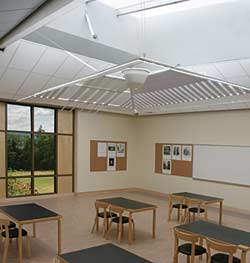Daylighting in Schools, Grades K-12
Control of Electric Lighting Output
Control of electric lighting output saves energy and improves the overall distribution of light when daylight is insufficient. A building designed for daylighting but without an integrated electric lighting system may even be a net energy loser because of the increased thermal loads. Only when the electric lighting load is reduced will there be more than offsetting savings in electrical and cooling loads. The benefits from daylighting are maximized when both lighting and occupancy sensors are used to control the electric lighting system. Combining lighting control strategies enhances building performance: Using occupancy sensors, daylight sensors, and time clocks with fluorescent dimming can help manage the lighting in an entire building and further reduce electric demand. Energy savings result when sensor and control technologies are employed in each classroom; maintenance is reduced because of less wear and tear on fixtures from using dimmers rather than on/off switches; and student productivity is increased through use of daylight and exact light levels for task needs.
| Common School Lighting Control Functions | Benefits |
|
Daylight Sensors and Dimming Ballasts |
Reduced energy use Even light level throughout classroom Non-distracting light level changes Increased productivity |
|
Occupant sensing |
No wasted energy when classrooms are empty |
| Dimming wall controls | Saved scenes for various presentation and computer/ classwork needs |
|
Table 1
|
|
Options for common school lighting control functions in classrooms, common areas, and other types of school areas can provide significant benefits. (Table 1.)
|
||||||||||||||
New installations and retrofits require different approaches. With a new installation, performance targets can be set and a light source and shading device can be chosen based on economic, ergonomic, and technical considerations, e.g., an acceptable payback period. With existing installations, choices will be limited by the building constraints, the availability of daylight, and the lighting controls used.










